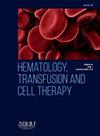The survivin/XIAP suppressant YM155 impairs clonal growth and induces apoptosis in JAK2V617F cells
IF 1.8
Q3 HEMATOLOGY
引用次数: 0
Abstract
The central role of the control of apoptosis in the pathophysiology of Philadelphia chromosome-negative myeloproliferative neoplasms has recently been reinforced in genetic and pharmacological studies. The inhibitor of apoptosis protein family has eight members and plays an important role in apoptosis, with the most studied being survivin (BIRC5) and X-linked inhibitor of apoptosis (XIAP). YM155 is a small molecule with antineoplastic potential that has been described as a suppressant of survivin and XIAP. In the present study, BIRC5 expression was significantly increased in primary myelofibrosis patients compared to healthy donors. On the other hand, XIAP expression was reduced in myeloproliferative neoplasms patients. In JAK2V617F cells, YM155 reduces cell viability and autonomous clonal growth and induces apoptosis, cell cycle arrest, and autophagy. HEL cells that show greater malignancy are more sensitive to the drug than SET2 cells. In the molecular scenario, YM155 modulates apoptosis-, cell cycle-, DNA damage- and autophagy-related genes. Protein expression analysis corroborates the observed cellular phenotype and exploratory gene expression findings. In summary, our results indicate that survivin/BIRC5 and XIAP are differently expressed in myeloproliferative neoplasms and YM155 has multiple antineoplastic effects on JAK2V617F cells suggesting that inhibitor of apoptosis proteins may be a target for pharmacological interventions in the treatment of these diseases.
存活素/XIAP抑制剂YM155可抑制JAK2V617F细胞的克隆生长并诱导其凋亡。
最近,遗传学和药理学研究进一步证实了控制细胞凋亡在费城染色体阴性骨髓增殖性肿瘤病理生理学中的核心作用。凋亡抑制蛋白家族有 8 个成员,在细胞凋亡中发挥着重要作用,其中研究最多的是存活素(BIRC5)和 X 连锁凋亡抑制因子(XIAP)。YM155 是一种具有抗肿瘤潜力的小分子,被描述为存活素和 XIAP 的抑制剂。在本研究中,与健康供体相比,原发性骨髓纤维化患者的 BIRC5 表达明显增加。另一方面,XIAP在骨髓增生性肿瘤患者中的表达减少。在 JAK2V617F 细胞中,YM155 可降低细胞活力和自主克隆生长,诱导细胞凋亡、细胞周期停滞和自噬。与 SET2 细胞相比,恶性程度更高的 HEL 细胞对该药物更敏感。在分子情景中,YM155 可调节细胞凋亡、细胞周期、DNA 损伤和自噬相关基因。蛋白质表达分析证实了观察到的细胞表型和探索性基因表达发现。总之,我们的研究结果表明,存活素/BIRC5 和 XIAP 在骨髓增生性肿瘤中的表达不同,YM155 对 JAK2V617F 细胞有多种抗肿瘤作用,这表明凋亡抑制蛋白可能是治疗这些疾病的药物干预靶点。
本文章由计算机程序翻译,如有差异,请以英文原文为准。
求助全文
约1分钟内获得全文
求助全文
来源期刊

Hematology, Transfusion and Cell Therapy
Multiple-
CiteScore
2.40
自引率
4.80%
发文量
1419
审稿时长
30 weeks
 求助内容:
求助内容: 应助结果提醒方式:
应助结果提醒方式:


